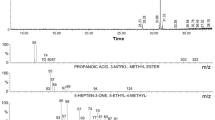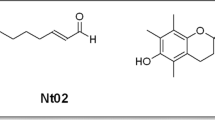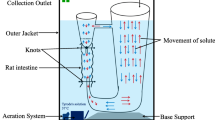Abstract
Purpose
Ferula asafoetida H.Karst. commonly known as Heeng in India belong to family Umbelliferae (Apiaceae) and has been known for neuroprotective, antioxidant, antispasmodic, hypotensive, hepatoprotective anthelmintic and antagonistic activities. This study was designed to elucidate the key compounds of asafoetida as potential anti alpha amylase and alpha glucosidase inhibitory role in curing the Type 2 Diabetes Mellites.
Materials
Based upon the literature survey various compounds of the asafoetida was deduced from the Pubchem and protein structure was deduced from protein data bank. Virtual screening was performed using Pyrx with α- amylase and α- glucosidase. Compounds with highest binding affinity score and 3-d interaction analysis was used to identify the potential inhibitors among various compounds. Pharmacokinetic studies for Drug likeliness and toxicity properties were characterized using SWISS ADME and ADMETSAR webservers.
Results
The docking scores, bindging affinity and 3d structure studies showed that Kamolonol, Gummosin, Picealactone B, Farnesiferol A are showing potential anti α- amylase whereas Epi-conferdione, Conferol, Feselol, and Farnesiferol C shows α- glucosidase inhibitory properties. The qualitative structural activity relationship for drug-likeness, pharmacokinetics and carcinogenicity analysis indicates that they are safe as drug molecules as these compounds follows the various parameters such as Lipinski’s rule of 5, anti-carcinogenicity etc.
Conclusions
This study shows that phytochemicals of F. asafoetida have the potential antidiabetic properties which could be further used to develop into effective antidiabetic drug from a natural resource.


Similar content being viewed by others
Abbreviations
- T2DM:
-
Type II diabetes Mellites
- T1DM:
-
Type 1 Diabetes Mellites DM
- IDDM:
-
insulin-dependent Diabetes Mellites
- NIDDM:
-
Noninsulin Dependent DM type 2 DM (T2DM)
- GDM:
-
Gestational DM
- ADMETSAR:
-
Absorption, distribution, Metabolism, excertion and toxicology associated Structural-activity relationship
References
Soumya D, Srilatha B. Late Stage Complications of Diabetes and Insulin Resistance. J Diabetes Metab [Internet]. 2011;02. Available from: https://www.omicsonline.org/late-stage-complications-of-diabetes-and-insulin-resistance-2155-6156.1000167.php?aid=3498.
Murea M, Ma L, Freedman BI. Genetic and environmental factors associated with type 2 diabetes and diabetic vascular complications. Rev Diabet Stud [Internet]. 2012;9:6–22. Available from: http://www.ncbi.nlm.nih.gov/pubmed/22972441.
American Diabetes Association. 2. Classification and Diagnosis of Diabetes: Standards of Medical Care in Diabetes-2021. Diabetes Care [Internet]. 2021;44:S15–33. Available from: http://www.ncbi.nlm.nih.gov/pubmed/33298413.
Spellman CW. Pathophysiology of type 2 diabetes: targeting islet cell dysfunction. J Am Osteopath Assoc [Internet]. 2010;110:S2-7. Available from: http://www.ncbi.nlm.nih.gov/pubmed/20382838.
Tripathy D, Chavez AO. Defects in insulin secretion and action in the pathogenesis of type 2 diabetes mellitus. Curr Diab Rep [Internet]. 2010;10:184–91. Available from: http://link.springer.com/https://doi.org/10.1007/s11892-010-0115-5.
Röder PV, Wu B, Liu Y, Han W. Pancreatic regulation of glucose homeostasis. Exp Mol Med. 2016;48:e219.Available from: https://www.nature.com/articles/emm20166.
Akinyede KA, Oyewusi HA, Hughes GD, Ekpo OE, Oguntibeju OO. In Vitro Evaluation of the Anti-Diabetic Potential of Aqueous Acetone Helichrysum petiolare Extract (AAHPE) with Molecular Docking Relevance in Diabetes Mellitus. Molecules [Internet]. 2021;27:155. Available from: https://www.mdpi.com/1420-3049/27/1/155.
Srisongkram T, Waithong S, Thitimetharoch T, Weerapreeyakul N. Machine Learning and In Vitro Chemical Screening of Potential α-Amylase and α-Glucosidase Inhibitors from Thai Indigenous Plants. Nutrients. 2022;14. Available from: https://www.mdpi.com/2072-6643/14/2/267/pdf.
Riyaphan J, Pham DC, Leong MK, Weng CF. In silico approaches to identify polyphenol compounds as α-glucosidase and α-amylase inhibitors against type-II diabetes. Biomolecules. 2021;11. Available from: https://pubmed.ncbi.nlm.nih.gov/34944521/.
Riyaphan J, Jhong CH, Lin SR, Chang CH, Tsai MJ, Lee DN, et al. Hypoglycemic efficacy of docking selected natural compounds against α-glucosidase and α-amylase. Molecules. 2018;23. Available from: https://www.mdpi.com/1420-3049/23/9/2260.
Rasouli H, Hosseini-Ghazvini SMB, Adibi H, Khodarahmi R. Differential α-amylase/α-glucosidase inhibitory activities of plant-derived phenolic compounds: A virtual screening perspective for the treatment of obesity and diabetes. Food Funct. Royal Society of Chemistry; 2017;8:1942–54. Available from: https://pubmed.ncbi.nlm.nih.gov/28470323/.
Habtemariam S. Antidiabetic potential of monoterpenes: A case of small molecules punching above their weight. Int. J. Mol. Sci. 2018. Available from: https://www.ncbi.nlm.nih.gov/pmc/articles/PMC5795956/.
Salehi, Ata V, Anil Kumar S, Ramírez-Alarcón R-O, et al. Antidiabetic Potential of Medicinal Plants and Their Active Components. Biomolecules [Internet]. 2019;9:551. Available from: https://www.mdpi.com/2218-273X/9/10/551.
Mahendra P, Bisht S. Ferula asafoetida: Traditional uses and pharmacological activity. Pharmacogn Rev. 2012;6:141–6. Available from: https://www.ncbi.nlm.nih.gov/pmc/articles/PMC3459456/.
Iranshahy M, Iranshahi M. Traditional uses, phytochemistry and pharmacology of asafoetida (Ferula assa-foetida oleo-gum-resin) - A review. J Ethnopharmacol [Internet]. 2011;134:1–10. Available from: https://linkinghub.elsevier.com/retrieve/pii/S0378874110008524.
Christensen LP, Brandt K. Bioactive polyacetylenes in food plants of the Apiaceae family: occurrence, bioactivity and analysis. J Pharm Biomed Anal [Internet]. 2006;41:683–93. Available from: http://www.ncbi.nlm.nih.gov/pubmed/16520011.
Homayouni Moghadam F, Dehghan M, Zarepur E, Dehlavi R, Ghaseminia F, Ehsani S, et al. Oleo gum resin of Ferula assa-foetida L. ameliorates peripheral neuropathy in mice. J Ethnopharmacol [Internet]. 2014;154:183–9. Available from: http://www.ncbi.nlm.nih.gov/pubmed/24709312.
Platel K, Srinivasan K. Influence of dietary spices and their active principles on pancreatic digestive enzymes in albino rats. Nahrung [Internet]. 2000;44:42–6. Available from: http://www.ncbi.nlm.nih.gov/pubmed/10702999.
Amalraj A, Gopi S. Biological activities and medicinal properties of Asafoetida: A review. J Tradit Complement Med [Internet]. Elsevier Ltd; 2017;7:347–59. Available from: https://doi.org/10.1016/j.jtcme.2016.11.004.
Kim S, Chen J, Cheng T, Gindulyte A, He J, He S, et al. PubChem 2019 update: improved access to chemical data. Nucleic Acids Res [Internet]. 2019;47:D1102–9. Available from: https://academic.oup.com/nar/article/47/D1/D1102/5146201.
Trott O, Olson AJ. Software news and update AutoDock Vina: Improving the speed and accuracy of docking with a new scoring function, efficient optimization, and multithreading. J Comput Chem [Internet]. 2010;31:455–61. Available from: https://doi.org/wiley.com/10.1002/jcc.21334.
Yuan Y, Pei J, Lai L. Binding Site Detection and Druggability Prediction of Protein Targets for Structure- Based Drug Design. Curr Pharm Des [Internet]. 2013;19:2326–33. Available from: http://www.eurekaselect.com/openurl/content.php?genre=article&issn=1381-6128&volume=19&issue=12&spage=2326.
Xu Y, Wang S, Hu Q, Gao S, Ma X, Zhang W, et al. CavityPlus: A web server for protein cavity detection with pharmacophore modelling, allosteric site identification and covalent ligand binding ability prediction. Nucleic Acids Res [Internet]. 2018;46:W374–9. Available from: https://academic.oup.com/nar/article/46/W1/W374/4994680.
Dallakyan S, Olson AJ. Small-molecule library screening by docking with PyRx. Methods Mol Biol. Springer; 2015. p. 243–50.Available from: https://pubmed.ncbi.nlm.nih.gov/25618350/.
Lipinski CA, Lombardo F, Dominy BW, Feeney PJ. Experimental and computational approaches to estimate solubility and permeability in drug discovery and development settings. Adv Drug Deliv Rev [Internet]. 2001;46:3–26. Available from: http://www.ncbi.nlm.nih.gov/pubmed/11259830.
Daina A, Michielin O, Zoete V. SwissADME: A free web tool to evaluate pharmacokinetics, drug-likeness and medicinal chemistry friendliness of small molecules. Sci Rep. Nature Publishing Group; 2017;7:1–13. Available from: https://www.nature.com/articles/srep42717.
Xiong G, Wu Z, Yi J, Fu L, Yang Z, Hsieh C, et al. ADMETlab 2.0: an integrated online platform for accurate and comprehensive predictions of ADMET properties. Nucleic Acids Res [Internet]. 2021;49:W5–14. Available from: https://academic.oup.com/nar/article/49/W1/W5/6249611.
Kaur N, Kumar V, Nayak SK, Wadhwa P, Kaur P, Sahu SK. Alpha-amylase as molecular target for treatment of diabetes mellitus: A comprehensive review. Chem Biol Drug Des [Internet]. 2021;98:539–60. Available from: https://onlinelibrary.wiley.com/doi/https://doi.org/10.1111/cbdd.13909.
Sakulkeo O, Wattanapiromsakul C, Pitakbut T, Dej-Adisai S. Alpha-Glucosidase Inhibition and Molecular Docking of Isolated Compounds from Traditional Thai Medicinal Plant, Neuropeltis racemosa Wall. Molecules. 2022;27. Available from: https://pubmed.ncbi.nlm.nih.gov/35163903/.
Nahoum V, Roux G, Anton V, Rougé P, Puigserver A, Bischoff H, et al. Crystal structures of human pancreatic α-amylase in complex with carbohydrate and proteinaceous inhibitors. Biochem J. 2000;346:201–8. Available from: https://www.ncbi.nlm.nih.gov/pmc/articles/PMC1220841/.
Shen X, Saburi W, Gai Z, Kato K, Ojima-Kato T, Yu J, et al. Structural analysis of the α-glucosidase HaG provides new insights into substrate specificity and catalytic mechanism. Acta Crystallogr. Sect. D Biol. Crystallogr. 2015. p. 1382–91. Available from: https://pubmed.ncbi.nlm.nih.gov/26057678/.
Panigrahy SK, Bhatt R, Kumar A. Targeting type II diabetes with plant terpenes: the new and promising antidiabetic therapeutics. Biologia (Bratisl) [Internet]. 2021;76:241–54. Available from: http://link.springer.com/https://doi.org/10.2478/s11756-020-00575-y.
Dandekar PD, Kotmale AS, Chavan SR, Kadlag PP, Sawant SV, Dhavale DD, et al. Insights into the Inhibition Mechanism of Human Pancreatic α-Amylase, a Type 2 Diabetes Target, by Dehydrodieugenol B Isolated from Ocimum tenuiflorum. ACS Omega. 2021;6:1780–6.Available from:. https://doi.org/10.1021/acsomega.0c00617.
Hamdan I, Afifi F. Studies on the in vitro and in vivo hypoglycemic activities of some medicinal plants used in treatment of diabetes in Jordanian traditional medicine. J Ethnopharmacol [Internet]. 2004;93:117–21. Available from: https://linkinghub.elsevier.com/retrieve/pii/S0378874104001576.
Latifi E, Mohammadpour AA, Nourani HBF H. Antidiabetic and antihyperlipidemic effects of ethanolic Ferula assa-foetida oleo-gum-resin extract in streptozotocin-induced diabetic wistar rats. Biomed Pharmacother [Internet]. Elsevier; 2019;110:197–202. Available from: https://doi.org/10.1016/j.biopha.2018.10.152.
Sonigra P, Meena M. Metabolic Profile, Bioactivities, and Variations in the Chemical Constituents of Essential Oils of the Ferula Genus (Apiaceae). Front Pharmacol [Internet]. 2021;11. Available from: https://www.frontiersin.org/articles/https://doi.org/10.3389/fphar.2020.608649/full.
Karimlar S, Naderi A, Mohammadi F, Moslehishad M, Delrish E, Aghajanpour L, et al. Hypoglycemic and Hypolipidemic Effects of Myrtus communis, Trachyspermum copticum and Ferula gummosa Essential Oils on Streptozotocin Induced Diabetic Rats. Nutr Food Sci Res [Internet]. 2019;6:1–8. Available from: http://nfsr.sbmu.ac.ir/article-1-318-en.html.
Acknowledgements
The author (GS) duly acknowledges the support of Computational lab developed under DST-FIST Level-0 Grant, Department of Science and Technology, Government of India. Author also acknowledges the support of the management and Principal, Dr. Gurpinder Singh Samra, Lyallpur Khalsa College, Jalandhar for encouragement and support.
Funding
No funding has been received from any academia or industry for the execution of this work.
Author information
Authors and Affiliations
Corresponding author
Ethics declarations
Conflict of interest
There is no conflict of interest.
Conflict of interest
Authors disclose no financial or non-financial interests that are directly or indirectly related to the work submitted for publication.
Additional information
Publisher’s note
Springer Nature remains neutral with regard to jurisdictional claims in published maps and institutional affiliations.
Electronic supplementary material
Below is the link to the electronic supplementary material.
Rights and permissions
About this article
Cite this article
Singh, G. Insilico screening and pharmacokinetic properties of phytoconstituents from Ferula asafoetida H.Karst. (Heeng) as potential inhibitors of α-amylase and α-glucosidase for Type 2 Diabetes Mellitus. J Diabetes Metab Disord 21, 1339–1347 (2022). https://doi.org/10.1007/s40200-022-01064-6
Received:
Revised:
Accepted:
Published:
Issue Date:
DOI: https://doi.org/10.1007/s40200-022-01064-6




